Rural Livelihoods Exercises
Question 1. You have probably noticed that people in Kalpattu are engaged, in a variety of non-farm work. List five of these.
Answer:

Question 2. Imagine you are a member of a fishing family and you are discussing whether to take a loan from the bank for an engine. What would you say?
Answer:
We would say that a loan from a bank is more advantageous than one from a moneylender.
- We should take a loan from the bank.
- If we put an engine in our catamaran; our catamaran will move more fast, and we can catch more fish.
Read and Learn More CBSE Solutions For Class 6 Social Science
Question 3. Poor rural laborers like Thulasi often do not have access to good medical facilities, good schools, and other resources. The difference between her and Ramalingam is one of inequality. Do you think this is a fair situation? What do you think can be done?
Answer:
We think inequality is not a fair situation.
The following things are to be done to remove this situation:
- Equal distribution of land among the people.
- Bank loans in place of loans from the moneylenders.
- Supply of seeds, fertilizers liquid pesticides at subsidized rates.
- Electricity at cheaper rates.
Question 4. What do you think the government can do to help farmers like Sekar when they get into debt? Discuss.
Answer:
When farmers get into debt like Sekar the government can do the following.
- The government should provide loans at lower interest rates.
- Subsidies should be granted on the purchase of seeds, fertilizers, and pesticides.
- Banks should be asked to give loans to farmers at lower interest rates.
- A loan waiver should also be implemented.
- License should be issued to moneylenders to remove wrong moneylenders.
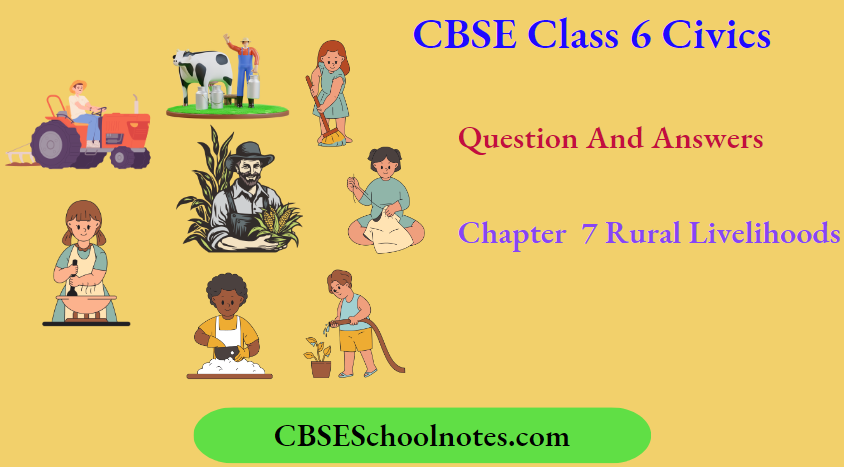
Question 5. Compare the situation of Sekar and Ramalingam by filling out the following table:
Answer:
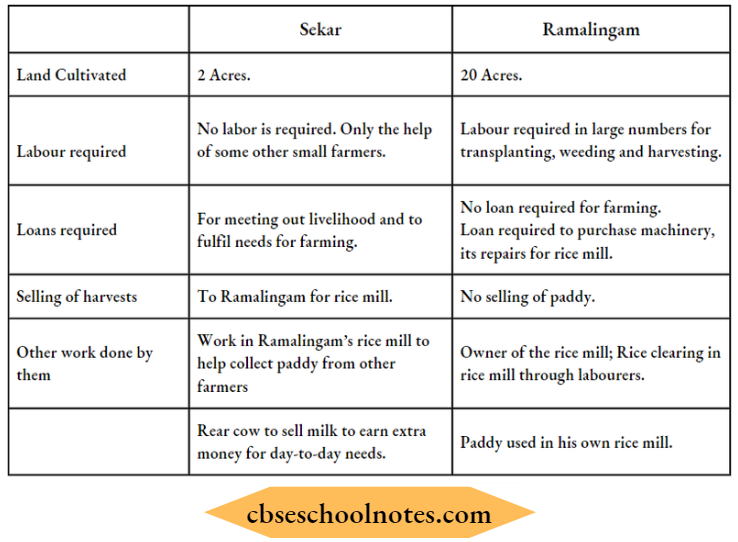
Question 6. Based on the below diagram would you say that Thulasi earns money throughout the year?

Answer:
Based on the diagram, I would say that Thulasi earns money only for seven months in a year:
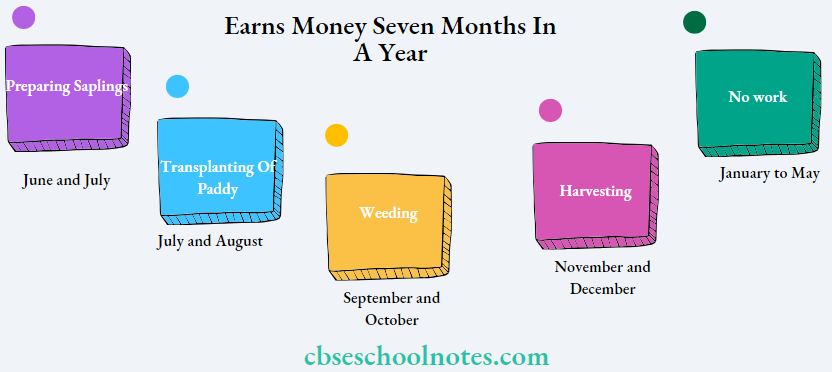
She does not. have work throughout the year.
Question 7.
1. Describe the work that Thulasi does. How is it different from the work Raman does?
Answer:
Thulasi Does The Following Works:
- She transplants paddy in the fields of Ramalingam.
- She weeds the plants.
- She harvests the paddy.
Other Works She Does At Her House Are:
- Cooking food
- Cleaning the house
- Washing the clothes
- Going to nearby forests to collect firewood.
- Fetching water from the borewell which is one kilometer away from her house.
- Taking care of her daughter
Thulasi’s Work Is Different From Her Husband’s.
- Her husband is Raman. He is also a laborer.
- His works are: Spraying pesticides
When There Is No Work In The Fields He
- Loads sand from the river;
- Loads stones from the quarry nearby;
- Gets material such as groceries for the house;
- Rears cow.
2. Thulasi gets paid very little money for the work she does. Why do you think agricultural laborers like her are forced to accept low wages?
Answer:
We Think Agricultural Laborers Are Paid Low Wages Because:
- Since most of them are landless they are forced to accept low wages.
- There are more number of landless workers than required.
- Most of them have taken loans so they have to accept the wages given to them.
- In spite of low wages in the village, he/she can also do other household work such as cooking, firewood collection, etc.
- If they go to cities, the cost of living is higher and their net income may be less.
3. In what ways would her way of earning a living have been different if Thulasi owned some farmland? Discuss.
Answer:
If Thulasi Had Some Own Land Her Way Of Working Would Have Been Different:
- She would not have been required to work as a farm laborer.
- She would have supervised the work of farm laborers,
- She may have required less loan.
4. What are the crops grown in your region or nearby rural area? What kinds of work do agricultural laborers do?
Answer:
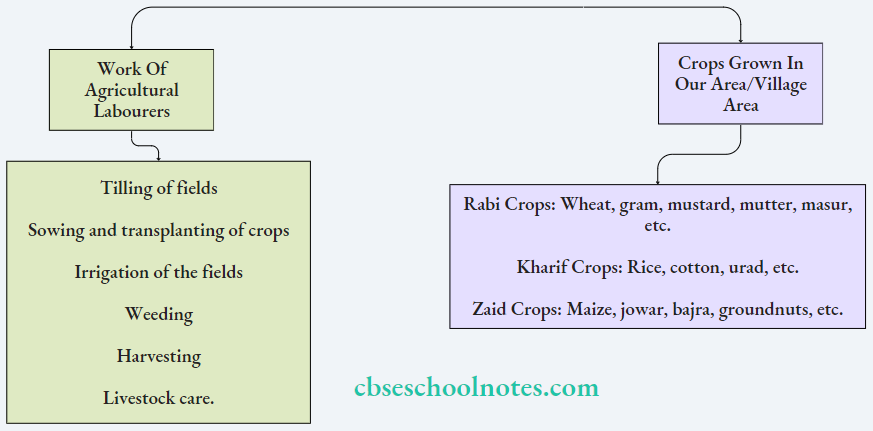
Question 8.
1. What work does Sekar’s family do? Why do you think Sekar does not usually employ laborers for doing farming work?
Answer:
Sekhar’s family does the farming work on a small piece of land.
- Sekar does not usually employ labourers for doing farming work; because he has a small plot of land where his family is sufficient to complete all farming activities.
- If he falls short of labourers, he takes help from other small farmers; and in turn, he helps them when they require labourers.
2. Why does Sekar not go to the town market to get a better price for his paddy?
Answer:
- Sekar does not go to the town market to get a better price for his paddy because he has to sell his product at lower prices to the moneylender.
- After selling the paddy to a moneylender, Sekar has little paddy which is to be consumed in his own house.
3. Sekar’s sister Mina had also taken a loan from the trader. She does not want to sell her paddy to him but she will pay back her loan. Write an imaginary conversation between Mina and the trader’s agent and the arguments given by each person.
Answer:
Conversation between Mina and the moneylender’s agent
- Moneylender’s agent: Mina, I am here to take the paddy in exchange for the loan.
- Mina: No, I shall not give the paddy to you as you are paying lower prices for my paddy. I shall sell it in the open market at a higher price and pay the loan in cash to you with interest.
- At this the agent is angry. He threatens Mina with the dire consequences for such a behavior.
- Mina is not frightened. She asks the agent to go away, and Mina sells the paddy in the open market and pays the loan in cash.
4. What are the similarities and differences between Sekar’s and Thulasi’s lives? Your answer could be based on the land that they have, their need to work on the land that belongs to others, or loans that they need and their earnings.
Answer:
Similarities And Differences Between The Lives Of Sekar And Thulasi:
Lives Of Sekar And Thulasi Similarities:
- Both Sekar and Thulasi are poor villagers.
- They both take a loan from Ramalingam.
- Both rear cows and sell milk to meet both ends.
Lives Of Sekar And Thulasi Differences:
- Sekar has a small plot of land, on which, he does farming activities with the help of his family.
- Thulasi has no land. She works as a landless laborer.
- Sekar works as a laborer only when he has no farming work.
- Thulasi also has to do household duties.
- Sekar sells the milk of his hybrid cow to the milk society.
- Thulasi has a simple cow and sells the cow to pay the loan that she has taken for the treatment of her daughter.
- Sekar takes loans to purchase seeds, fertilizers, and pesticides.
- Thulasi takes a loan for the treatment of her daughter.
- Sekar works on the field of others in exchange for work done on his field by the other farmers.
- Thulasi works in the fields of Ramalingam as a landless laborer.
Question 9. Read again Sekar’s and Thulasi’s accounts. What do they say about Uamalingam, the large farmer? Together with what you have read fill in the details below:
- How much land does he have?
- What does Ramalingam do with the paddy grown on his land?
- Apart from farming how else does he earn?
Answer:
Both Sekar and Thulasi have high opinions about Ramalingam. He is a large farmer but is very kind. He gives loans to small farmers and landless laborers.
The rate of wages he pays is low but the people are assured that when required he would employ them in his fields, he would not call laborers from outside.
- He owns 20 acres of paddy land in the village.
- Ramalingam sends paddy grown in his fields to his rice mill to produce rice.
- He earns from selling rice produced in his rice mill, in the market.
Question 10.
1. Why do both Sekar’s and Aruna’s families have to borrow? What similarities and differences do you find?
Answer:
Sekar’s and Aruna’s families have to borrow for long periods to survive.
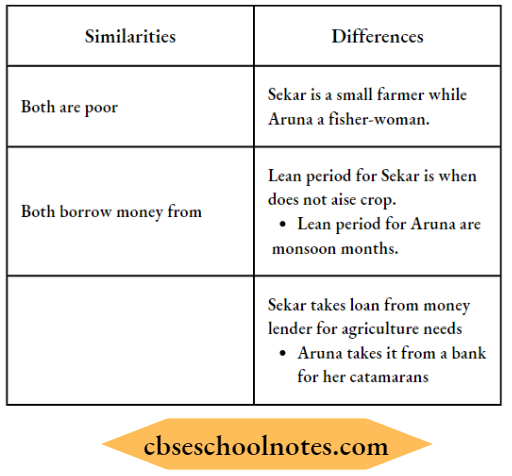
2. Have you heard of tsunamis? What is this and what damage do you think it might have done to the lives of fishing families like Aruna’s?
Answer:
- Yes, we have heard of a tsunami.
- A tsunami is an ocean wave caused by an earthquake or volcanic eruption on the floor of the sea.
- It would cause damage to Aruna’s house, catamaran, nets, etc.
Question 11. In India, 80 percent of farmers belong to this group. Only 20 percent of fishing etc. For example, in some villages in central India, both farming and collection from the forest are important sources of livelihood.
Would you say that a majority of the country’s farmers are quite poor? What do you think can be done to change this situation?
Answer:
From the Figures, we would certainly say that a majority of the country’s farmers are quite poor.
We think that if some of the following measures are taken for them the situation can be changed:
- Distribution of land, who do not have land.
- Fixation of farm wages.
- Loan facilities from government-run credit institutions.
- Marketing facilities for selling agricultural produce in all the villages.
- Curb on moneylenders.
- Distribution of seeds, fertilizers, and pesticides by Govt, agencies
Rural Livelihoods Very Short Answer Type Questions
Question 1. Where is Kalpattu village situated?
Answer:
Kalpattu village is situated close to the sea coast in Tamil Nadu.
Question 2. What was the main crop of Kalpattu village?
Answer:
The main crop of Kalpattu village is paddy (rice).
Question 3. What do some people do when they go to towns?
Answer:
They work as construction workers and lorry drivers.
Rural Livelihoods Short Answer Type Questions
Question 1. What are the different occupations on which rural families depend for livelihood?
Answer:
Rural families mainly depend upon farming for livelihood.
Other Occupations Are:
- Collection from forest like mahua or tendu leaves, honey, etc.
- In animal husbandry, they rear animals and sell milk to cooperatives or nearby cities.
- In coastal areas, fishing is an important occupation.
- They also do a lot of non-earning activities like working for their households.
Question 2. Write the different activities performed by the people of Kalpattu village.
Answer:
People of Kalpattu village mainly earn a living through paddy cultivation. Some arc landless and work for others. Other activities are:
- They do non-farming activities like weaving baskets, making utensils, bricks, etc.
- There are blacksmiths, nurses, teachers, barbers, cycle mechanics etc.
- There are different shops and traders also like tea shops, grocery, tailors, seed shops, etc.
- The tea shops also sell tiffins—idli, vada, dosa, upama, etc.
- There are coconut groves and sugarcane, banana trees also. People work there to earn a living.
Question 3. Write some sentences on the work of agriculture.
Answer:
- Agriculture is the main work of the village people.
- Paddy is the main crop grown in the irrigated fields.
- Other crops are cotton, sugarcane, and plantain (banana and coconut trees).
- Some coconut groves are also there,
- There are several mango orchards.
Question 4. Why had Thulasi and Raman to sell their cow?
Answer:
- Thulasi and Raman had school-going daughters. They lived with them with joy.
- One of the daughters fell ill last year.
- She was taken to the hospital for treatment.
- They borrowed money from Ramalingam for her treatment.
- They had to sell their cow for payment of a loan they had borrowed from Ramalingam.
Question 5. Describe the life of the landless or agricultural laborers in rural areas.
Answer:
Life of agricultural laborers in rural India.
- Nearly 66.67% of the population in rural areas is an agricultural laborer.
- Some of them have their own small plots of land which cannot give them enough to earn their livelihood. Most of them are landless.
- They have to go to distant places or nearby towns to find work. This is called migration.
Question 6. What difficulty Thulasi faced, when she grew old?
Answer:
That now Thulasi is old, She finds bedding for long hours while working in the paddy field, with feet in the water, very painful.
Question 7. When there is no work what did Raman do
Answer:
- He loads sand from the river bank or stones from the nearby quarry into the lorries.
- These lorries are sealed to nearby towns to make houses.
Question 8. Write about some large farmers.
Answer:
- These large farmers are about. 20% of Indian farmers.
- They cultivate most of the land in the villages.
- A large part of their produce is sold in the market.
- Many of them have started other businesses such as shops, moneylending, trading, and small factories.
Rural Livelihoods Long Answer Type Questions
Question 1. Why do farming communities commit suicide in some areas?
Answer:
In some areas fanning communities commit suicide for the following reasons:
- Fanners very often take loans from moneylenders for the purchase of seeds, fertilizers, and pesticides.
- Sometimes seeds are not good while on other occasions, pests damage crops resulting in crop failure.
- Bad monsoons also damage crops.
- The loan goes on mounting and there is no way for the farmers to repay the loan.
- They become helpless and sometimes they commit suicide.
Question 2. Read the following account (terrace farming in Nagaland) and answer the questions that follow it:
Terrace Farming In Nagaland
This is a village called Chizami which is in Phek district in Nagaland. The people of this village belong to the Chakhesang community. They do ‘termed cultivation. Each group eats together once their work’ for the day is over. This goes on for several days until the work is completed.
- Which village is referred to in the picture above? Where is it located?
- What type of farming do they practice?
- For what is this practice the best?
- What activities people of Chizarni do collectively?
Answer:
- Chizarni, in Phek district of Nagaland.
- Terrace farming
- Rice cultivation
- To carry out the farming activities.
- To clean the mountainside of the weeds.
- They eat together, often after finishing the work.
Question 3. Describe the life of fishing communities.
Answer:
People of the coastal village (Pudupet) earn a living through fishing.
- Their life starts at 2 o’clock in the morning. Fishermen go with nets and catamarans to catch fish.
- By 7 o’clock they return and women gather to buy or sell fish.
- During the months of monsoon, they do not catch fish. They survive on borrowings from moneylenders.
- During the fish-catching period, they repay the loan by selling the fish to the moneylenders.
